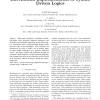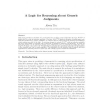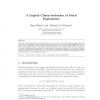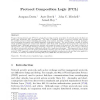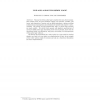78
Voted
JSYML
2006
15 years 16 days ago
2006
Abstract. We present a generalisation of the type-theoretic interpretation of constructive set theory into Martin-L
JSW
2006
15 years 16 days ago
2006
Abstract-- This paper describes a technique combining higher order functions, algebraic datatypes, and monads to incrementally implement syntax driven logics. Extensions can be com...
112
click to vote
ML
2008
ACM
15 years 16 days ago
2008
ACM
Abstract. We revisit an application developed originally using Inductive Logic Programming (ILP) by replacing the underlying Logic Program (LP) description with Stochastic Logic Pr...
95
Voted
ENTCS
2007
15 years 16 days ago
2007
We define a logic EpCTL for reasoning about the evolution of probabilistic systems. System states correspond to probability distributions over classical states and the system evo...
90
Voted
ENTCS
2007
15 years 16 days ago
2007
This paper presents an extension of a proof system for encoding generic judgments, the logic FOλ∆ of Miller and Tiu, with an induction principle. The logic FOλ∆ is itself an...
90
Voted
ENTCS
2007
15 years 16 days ago
2007
The work of Abadi and Fournet introduces the notion of a frame to describe the knowledge of the environment of a cryptographic protocol. Frames are lists of terms; two frames are ...
ENTCS
2007
15 years 16 days ago
2007
Protocol Composition Logic (PCL) is a logic for proving security properties of network protocols that use public and symmetric key cryptography. The logic is designed around a pro...
108
click to vote
JOLLI
2006
15 years 16 days ago
2006
Abstract. In this paper we study families of resource aware logics that explore resource restriction on rules; in particular, we study the use of controlled cut-rule and introduce ...
98
Voted
ENTCS
2007
15 years 16 days ago
2007
Description Logics (DLs) are a family of logic based knowledge representation formalisms. Although they have a range of applications, they are perhaps best known as the basis for ...
127
click to vote
LOGCOM
2008
15 years 16 days ago
2008
The practice of first-order logic is replete with meta-level concepts. Most notably there are meta-variables ranging over formulae, variables, and terms, and properties of syntax s...

